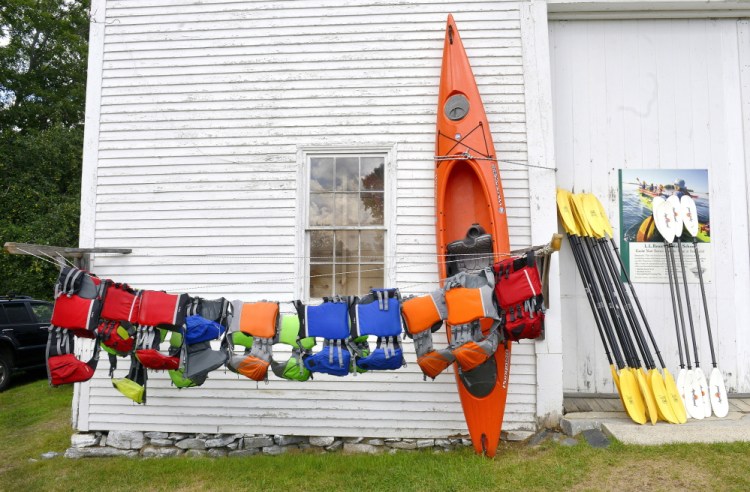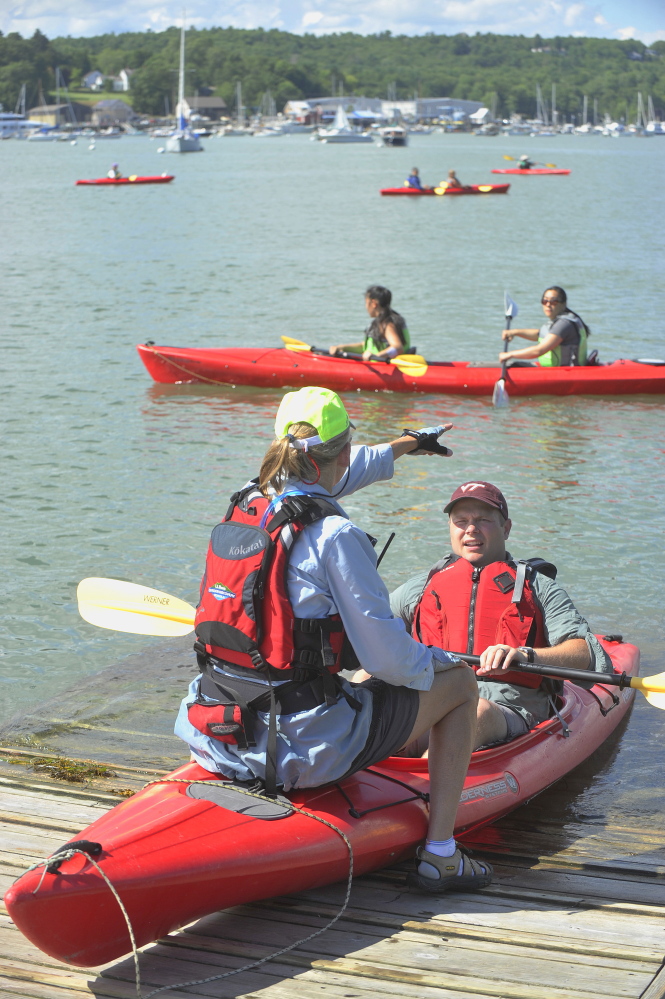An 18-year-old paddling an 8-foot kayak off the coast of Swan’s Island was caught unprepared Tuesday afternoon when high winds and rain roiled the ocean. With no cellphone, radio or life jacket, Jackson Day spent the night on a nearby island while a helicopter and a small flotilla of boats searched for him in the waters southwest of Mount Desert Island.
Also Tuesday, two brothers from Connecticut were paddling on Rangeley Lake when the 17-year-old’s 10-foot kayak was swamped and he was forced to cling to his 23-year-old brother’s boat. Joel Longsoy was unable to make headway against the wind and used his cellphone to call for help. His younger brother Mark was wearing a life jacket, but he became hypothermic in the 55-degree water during the 50 minutes it took to get rescued.
It was a different story early this month, when a Pennsylvania couple canoeing off Jonesport apparently capsized. The body of Roy Carlile, 58, was found tangled in lobster gear, and his wife, Judith Carlile, 53, was discovered the next day nearby. An autopsy revealed that despite having life jackets, they died of drowning likely caused by hypothermia.
The Coast Guard and Maine Marine Patrol have seen an uptick in the number of search-and-rescue calls involving canoes and kayaks this summer, a reflection of the continued popularity of paddle sports and the need, experts say, for better preparation and respect for the potential hazards of the marine environment.
“During the busy summer months, when the weather is good, it’s unusual to have a weekend where we don’t have some kind of response on the coast, to search or for a potential drowning,” said Col. Jon Cornish, head of the Maine Marine Patrol. “We hope we’re through the worst of it, but in Maine, September seems to become a busier and busier month.”
UNPREDICTABILITY AND PREPARATION
Kayaking in particular has become a popular way to see the coast, and guides and other experts say having the right boat for the conditions and the proper safety gear are essential to avoiding trouble. A key for paddlers is understanding the environment they are heading into.
“The waters off the coast of Maine are just very dynamic. Conditions can change very quickly – cold water, strong currents, fog often,” said Zack Anchors, who runs Portland Paddle, a kayak rental and training outfit. “Things can be very calm and placid one moment and (then) very choppy and challenging for kayakers another moment.”
One of the most important steps any boater can take before setting out is checking the weather. Cornish noted that the wind and rain that drove Day off course near Swan’s Island were expected and should have influenced how long he stayed out.
Another easy precaution that paddlers should take is letting someone know where they plan to go and when they plan to return, even leaving a note on the windshield if parked near a launch.
“Hearing about a missing person two hours after they should have been back is rough on search and rescue,” Cornish said. “We’d rather have people be alarmist than procrastinate.”
The most important piece of safety equipment – and the one that is most commonly missing in boating fatalities – is a life jacket.
But Coast Guard Petty Officer 3rd class Ross Ruddell says just having a life jacket often isn’t enough.
“A lot of people have life jackets with them when on a kayak or canoe trip, but shoved up under the front of the boat,” he said. “When you capsize, it is much more difficult than you think to put a life jacket on in the water versus having it on” already.
RIGHT BOAT MAKES BIG DIFFERENCE
Maine Game Warden Patrick Egan responded when the two brothers were stuck on Rangeley Lake and says it was fortunate the one who fell in had a life jacket on.
“That’s probably what saved him because after about 15 to 20 minutes, he doesn’t remember anything else. Hypothermia had set in,” Egan said.
Water temperature itself can be fatal, and paddlers should consider wearing a wet suit, dry suit, or at least neoprene and fleece clothing that won’t absorb water and will provide some insulation if a boater goes in the water, said Scot Balentine, manager of product development in L.L.Bean’s sporting goods department.
When Marine Patrol Officer Benjamin Burnes jumped in to save two Massachusetts canoers in the York River last month, one of them said afterward he could no longer feel his arms or legs and would have drowned if the officer hadn’t arrived.
Boaters also need to have the right boat.
Canoes have been a staple of Maine’s lakes and rivers for generations and are ideal for transporting the family for a picnic, but they are not well-suited for the ocean or rough conditions because they are affected more by the wind and can be easily swamped by waves.
Many beginner kayakers like the initial stability of a short, relatively wide kayak, with an open cockpit, which are suited to lakes and rivers or for staying close to shore to fish or just enjoy the sun, Balentine said.
Longer kayaks, sometimes with a skeg or rudder, are more appropriate for excursions on open water – like to sections of the Maine Island Trail – where wind and waves can become an issue.
“Sea kayaks generally are faster and track better – easier to make go straight,” Anchors said. “They just handle much better in choppy seas and challenging ocean conditions. If you do find yourself paddling and the wind picks up, if you’re in a really short river kayak you’re going to have a really difficult time getting to shore.”
RADIOS, CELLPHONES, GUIDED TRIPS
Balentine said the boat also needs to be seaworthy – like having a spray skirt to keep waves from filling the cockpit, and having sealed air compartments fore and aft so the boat won’t sink if it gets swamped.
Getting back underway in a kayak that has tipped over is a matter of equipment and, more importantly, training, Balentine said.
Getting out of the boat and then getting back into it are skills that are taught at many introductory classes. Having another boater nearby or a paddle float will help a paddler get back into a kayak, and a pump is important for getting the water out of it. They are skills that need to be acquired through practice, Balentine said.
“You don’t want to be opening the book up when you’re sitting in the water,” he said.
A cellphone or radio also is essential gear. Most areas along the coast get cellphone reception, so keeping a phone in a waterproof bag is a good safety measure.
Balentine said hand-held radios can be useful tools because they usually include a weather function that can alert a boater when conditions are deteriorating.
Lt. Scott McCann, of Coast Guard Station South Portland, recommends the radio over the cellphone because a radio broadcast will be picked up by other boaters, who might be close by and in a position to help. The Coast Guard also has technology for pinpointing the location of a transmission even if a person can simply radio a mayday but is unable to communicate where they are, he said.
Other important equipment includes a compass and chart, in case fog moves in, a noisemaker like a horn to signal other boaters, and a strobe or flare.
Anchors, at Portland Paddle, said many of the people who visit his rental shop, as well as others up and down the coast, are neophytes.
“I think a lot of the outfitters on the coast of Maine, we try to get those people into guided trips,” he said. “For really getting out to the islands of Maine, exploring the Maine Island Trail, you really need the local knowledge a guide provides and the kind of safety skills that a guide can provide.”
SEARCH-AND-RESCUE OPERATIONS
Even experienced paddlers run into problems, sometimes because they have been doing it so long they don’t feel they need to take the same precautions.
“A lot of times those are the people who concern us the most, whether they’re our customers or just the public: people who have been out paddling for years and maybe have been lucky and just been in really good conditions and they’re not prepared for the kind of conditions that can come up,” Anchors said.
The Coast Guard launched 442 search-and-rescue operations in northern New England in fiscal year 2014, more than 100 of them responding to kayaks and canoes, said Ruddell, the Coast Guard petty officer. So far this year, the Coast Guard has launched 338 search-and-rescues, including more than 100 involving kayaks and canoes, with a month of the recreational boating season still to go.
“There has been an uptick in kayak-related search-and-rescue cases in northern New England,” Ruddell said. “Based on last year and the way cases are going this year, we would expect to see that continue to rise.”
The figures are a little deceiving because they include the times when small boats are found adrift without owner information, which rivals the number of actual rescue missions for craft that size. The Coast Guard needs to treat the situation like a missing boater until it knows otherwise, Ruddell said. The Coast Guard Auxiliary offers stickers to boaters for affixing contact information to boats in case they’re found adrift.
McCann, of Coast Guard Station South Portland, said safe paddling involves a short list: Practice on calm waters before going on the ocean, check the weather forecast, and file a float plan. The Coast Guard’s safe boating app – available at uscg.mil/mobile/ – is another tool for boaters.
While on the water: Wear a life jacket and know how it works, carry some type of communication device, and don’t go alone.
Search-and-rescue workers will appreciate it.
“We’ve all dealt with families and loss, those of us who’ve been here a while, and it’s a tough thing,” Cornish said of having to notify families that a loved one has drowned. “We all breathe a sigh of relief when these things turn out OK.”
Send questions/comments to the editors.




Success. Please wait for the page to reload. If the page does not reload within 5 seconds, please refresh the page.
Enter your email and password to access comments.
Hi, to comment on stories you must . This profile is in addition to your subscription and website login.
Already have a commenting profile? .
Invalid username/password.
Please check your email to confirm and complete your registration.
Only subscribers are eligible to post comments. Please subscribe or login first for digital access. Here’s why.
Use the form below to reset your password. When you've submitted your account email, we will send an email with a reset code.